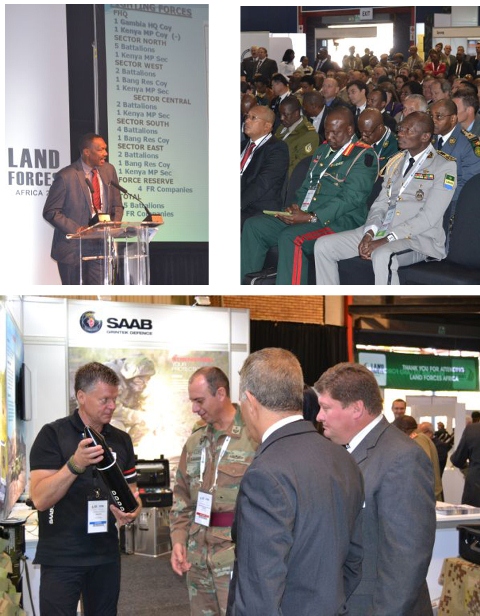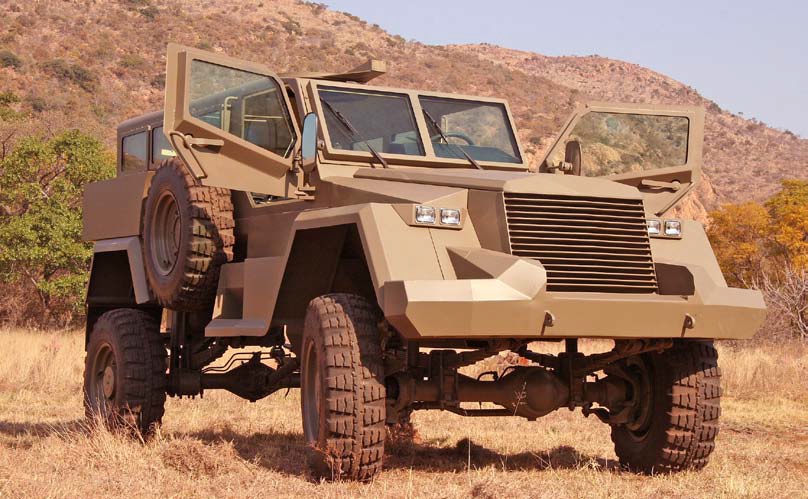East African Nation Places Order For Purchase of South African All-terrain Armored Personnel Carriers as African Equipment goes on Display.
JOHANNESBURG, South Africa: The annual Land Forces Africa military expo took place in Thaba Tshwane, Pretoria, during the second week of July, 2015, with a record attendance of over 1,000 participants, made of over 300 military personnel, as well as government representatives, members of the emergency services and the defence industry.
A wide range of armoured vehicles, medical equipment, munitions and C4ISR were on display as a two-track conference where matters relating to military interoperability in peace-keeping and humanitarian operations continued as well. The discussions focussed on strategic, operational and technical operability, with particular emphasis on increased collaboration across all sectors. Exhibitions were both indoor and outdoor.
The expo, while showcasing military hardware, was also the meeting point for development ideas through military affairs. The Land Forces Africa 2015 conference and exhibition took place from Monday, July 6 to July 7, 2015.
African countries should cooperate more in defence, including defence technology and the defence industry, in order to strengthen the continent’s sovereignty, peace and development, the retired South African Navy Vice Admiral Johannes Mudimu told delegates during his opening address. The retired Admiral is currently South African Defence Acquisitions, Disposals and Research and Development Agency (Armscor) Board Chairperson.
“I stand before you against a background of a troubled Africa,” Mudimu told the assembled delegates.
He cited major terrorist attacks in a number of African countries in recent months and days, including in Egypt, Kenya and Tunisia. He noted there had been attacks on government officials, members of the security forces and civilians. He also cited, as an example of a different kind of problem, the current instability in Lesotho, where it had been thought that this problem had been overcome, [but where], the former head of the country’s army had recently been killed (in unclear circumstances).
“Is this the Africa we want?” retired Navy Vice Admiral Mudimu asked.
He then argued that Africa had to be able to develop itself. It had to be able to achieve and maintain peace, reminding delegates that the theme of this year’s conference was “advancing Africa’s defence and security objectives through interoperability”.
He stressed that the continent needed to be able to develop its own capabilities, including technologies and industries, that would result in affordable products suitable for Africa. This would strengthen the continent’s sovereignty and independence.
He pointed out that technology was essential for development. Africa had to learn how to develop defence technology and produce civilian spin-offs.
The ultimate objective is “an Africa of hope and development”, he affirmed. “Together we can give our people a better future.” In answer to a question, Mudimu suggested that pan-African defence collaboration could start with each country carrying out a survey of its indigenous defence capabilities (especially in terms of technology and industry) and what it could offer to cooperative projects.
“Have we done this sort of analysis in Africa?” he queried. This would also establish what capability gaps existed on the continent. This, in turn, could lead to the identification of the best international (non-African) partners to work with to fill these gaps.
“The opportunity around interoperability … requires inter-State and multinational mechanisms for us to really make an impact on the continent,” observed Armscor CEO Kevin Wakefield in his address. “Just imagine if African States collaborate, for example, about buying military technology.”
Such collaboration would greatly increase African buying power and provide African countries with the muscle to negotiate the establishment of assembly lines and production facilities on the continent. Creating supply chains across the continent would bring logistical benefits, he said.
The aim should be non-competitive collaboration. But there were, cautioned Wakefield, a number of questions that had to be answered first. “How do we collaborate? Through investments? The provision of services? How do we avoid externalising [outside Africa] all our wealth and all our intellectual property? … It can be done. It has been done elsewhere.”
But there remain lots of challenges, including financial ones. The aim is to create an African defence industry that is a leader and that creates jobs across the continent. This will require cooperation with industries outside the continent. How will this be done–to develop the local industry–is a key question.
“Africa will always collaborate with the rest of the world,” he assured. “But it is what form of collaboration we entertain,” that is important — it has to be a form that does not externalise the results of Africa’s efforts.
A separate Land Forces Africa report says a country in East Africa placed an order at the military equipment ‘trade fair’ at Thaba Tshwane, Pretoria for purchase of the military vehicles Springbuck APC’s from its producers based in South Africa, DCD Protected Mobility.
The ballistic and landmine protected, all-terrain armoured personnel carrier ensures crew protection, easy to operate, maintain and repair. The name of the country is not disclosed by the report. The vehicle’s ballistic level of protection “is B6 upgradeable to B7,” the report says. The all-steel Armoured V-shaped hull is designed to withstand a TM57 landmine off 7kg directly under the hull, or two under any wheel.
The East African nation has accepted the Springbuck APC as a perfect solution with an order of undisclosed number of vehicles.
Suppliers of the vehicle, DCD Protected Mobility continues to increase cooperation in the International market with its footprint well established in 14 countries including South Africa. DCD PM continues to thrive on designing the safest platform for route clearance .
“We strive to provide innovative, affordable and sustainable products and solutions to meet the Defence requirements” the General Manager of DCD PM Cornelius Grundling said, adding furthermore, that ” with DCD Protected Mobility now operating from the Boksburg facility, one of its manufacturing and production facilities, we continue to bring technical expertise and experience”.
Cornelius said ” DCD Protected Mobility owns all of the Intellectual Property (IP) related to our products. A significant premium is allocated on the research and development of our own IP. We continue to work with our well established alliances in technology both locally and internationally, with the aim of providing a complete solution to our customers”. DCD Protected Mobility was one of the sponsors of Land Forces Africa 2015. Engineeringnews.co.za contributed to this report.






